The Sabine River begins east of Dallas, Texas in the confluence of three branches: the Cowleech Fork, Caddo Fork, and South Fork, which is submerged under Lake Tawakoni. From there, it flows roughly east and southeast for 360 miles toward Louisiana, where it forms part of the Texas-Louisiana border before draining into Sabine Lake.
Centuries of use by people, from native tribes like the Caddo to French and Spanish explorers, ferry operators, and riverboat captains give the Sabine River a rich history. Yet, that isn’t what we are after today. No. Today, we want to know about the snakes.

©Billy Hathorn at en.wikipedia, CC BY-SA 3.0 – License
As you may know, Texas is home to about 14 venomous snakes — more than some states, and Louisiana claims seven venomous snakes. So, if you spend time exploring the river’s 360 miles, there is a good chance you’ll run into a snake — venomous or not. Here are a few of the snakes you can expect to see.
Western Ratsnake (Pantherophis obsoletus)
One of the most entertaining of all our snakes is the western ratsnake. This species has no problem living near people; they even take up residence in garages and sometimes kitchens. However, their natural habitat is located in the trees and brush.
Western ratsnakes are rodent specialists, although they are happy to eat a bird or three along the way. You are more likely to find this rather large snake in the trees than on the ground, but anything could happen.
Growing to about six feet long, western rat snakes have a dark pattern of blotches down their back. As they mature, their colors become black or nearly black; you may find these snakes anywhere along the Sabine River.
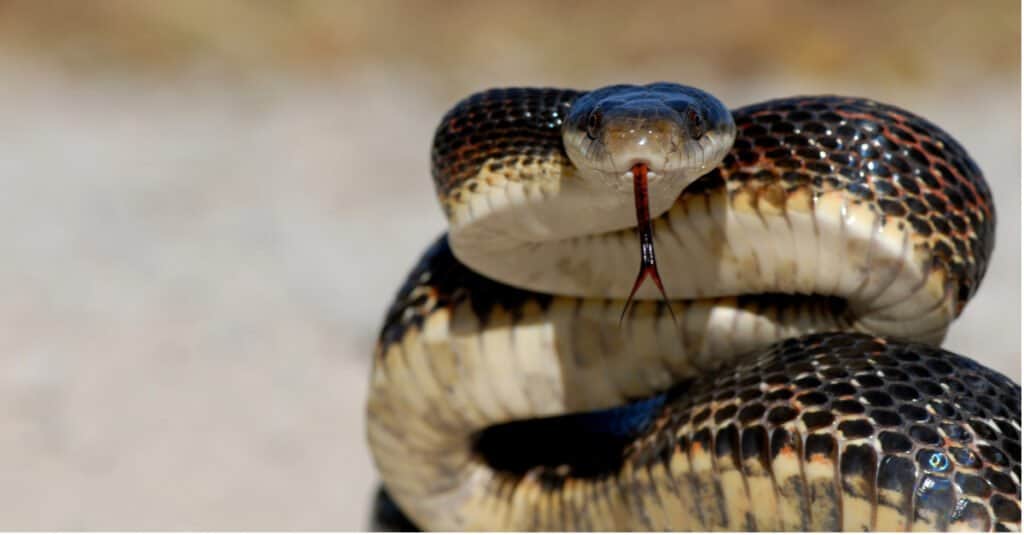
Western ratsnake showing ‘S’ shape in a defensive posture. Like gopher snakes, rat snakes try to bluff their way out of situations.
©Rusty Dodson/Shutterstock.com
Diamondback Watersnake (Nerodia rhombifer)
Perhaps a bit thinner than its stockier cousin the plain-bellied watersnake, diamondback watersnakes are one of the longest watersnake species. They’re called diamondback watersnakes because their pattern is roughly diamond-shaped. Many people describe it as being similar to how a chainlink fence looks — which is pretty accurate.
These snakes prefer slower-moving waters, so they tend to stick closer to the shore. Diamondback watersnakes like to dangle above the water, just dipping their head in, while watching for fish to catch with razor-sharp teeth.
Diamondback watersnakes are not venomous but pack a nasty bite. Like most watersnakes, this species aggressively defends itself. That is, it’s not going to chase you down. However, grabbing one will leave you with several painful bites.
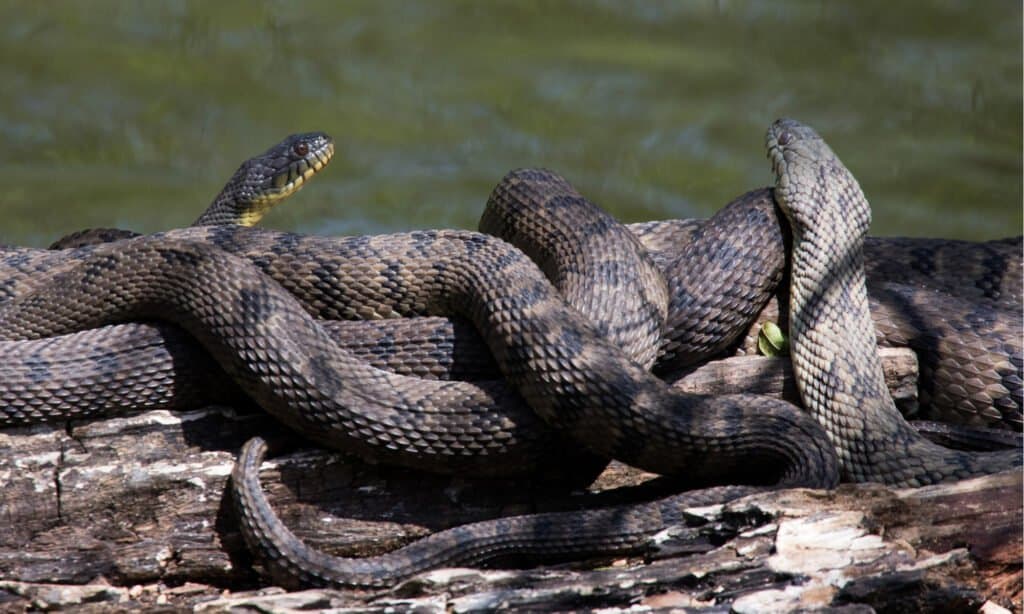
Diamondback watersnakes eat more frogs, toads, and salamanders than other watersnakes.
©Laurie L. Snidow/Shutterstock.com
Plain-Bellied Watersnake (Nerodia erythrogaster)
Another nonvenomous, fish and frog-eating watersnake with a nasty bite, plain-bellied watersnakes are common snakes in and around the Sabine River. There are several subspecies, which relate to location and the color of their belly which can range from yellow or cream to red.
As their name suggests, these snakes have a solid-colored belly, with no markings. Plain-bellied water snakes are mistaken for venomous cottonmouths constantly. Their dark colors and heavily-keeled scales make them look similar at a distance. However, a quick look at their heads with vertical bars around their lips, round pupils, and eyes that are set higher on their heads should make it easier.
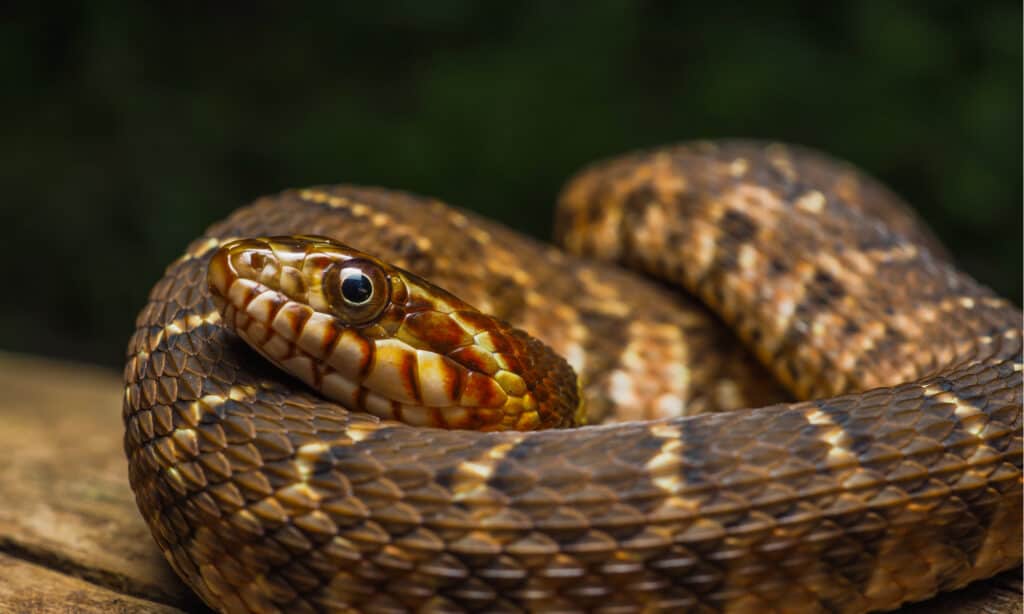
Young plain-bellied watersnakes have brighter patterns that fade as they mature.
©Tyler Albertson/Shutterstock.com
Broad-Banded Watersnake (Nerodia fasciata confluens)
This species is a banded watersnake subspecies. However, they’re so common along the Sabine River that they deserve a mention all by themselves.
Broad-banded watersnakes have a gorgeous black base color with red-orange bands spaced several inches apart. Like other watersnakes, they are ready and willing to use those teeth for defense, but they aren’t dangerous.
Their diet is similar to that of other watersnakes — fish, amphibians, sometimes crayfish, and other aquatic animals. Broad-banded watersnakes often hang from branches above the water – either basking or waiting for prey. When they spot a prey or a threat, they slip away without being noticed.
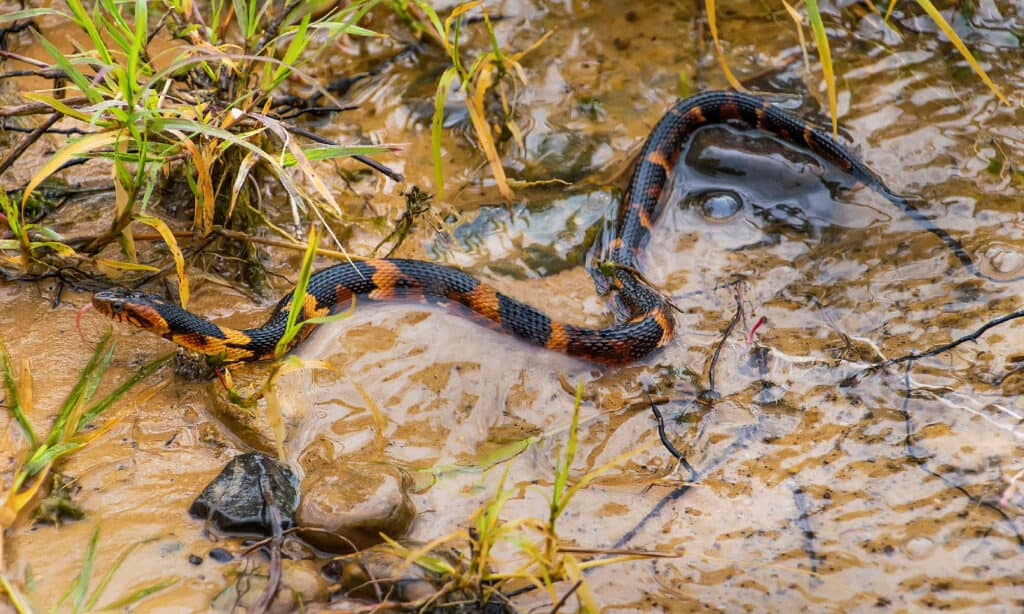
Broad-banded watersnakes have distinctive red-orange-yellowish bands.
©iStock.com/williamhc
Western Ribbon Snake (Thamnophis proximus)
Semiaquatic by nature, western ribbon snakes are usually close to water. They are garter snake cousins and have similar features. Western ribbon snakes have three clearly defined stripes that begin behind their heads and run the length of their bodies over a dark base color.
Ribbon snakes are harmless and typically eat fish, frogs, tadpoles, and earthworms. This common snake lives in wet areas and occurs along most of the Sabine River.
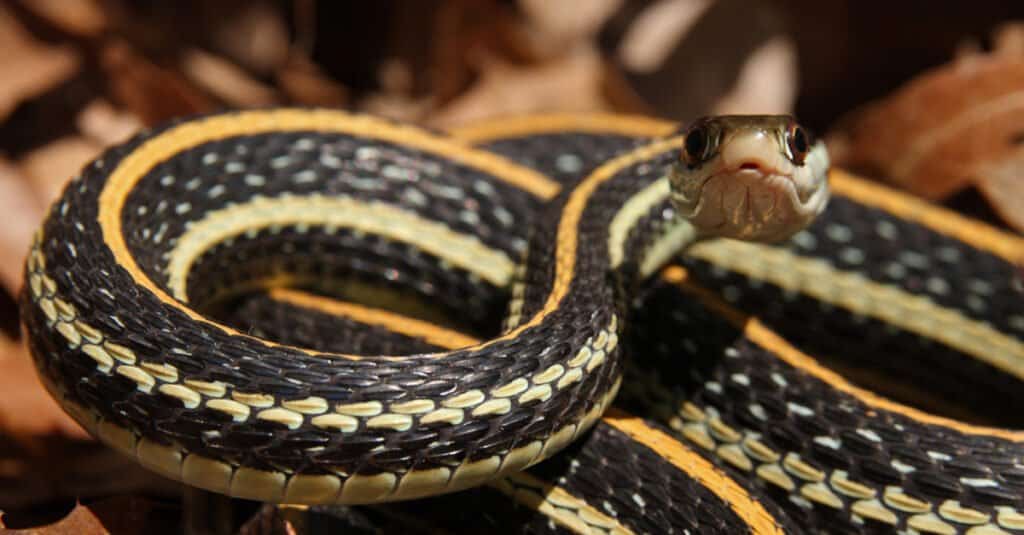
A western ribbon snake, showing a clearly defined dorsal stripe.
©Ryan M. Bolton/Shutterstock.com
Coachwhip (Masticophis flagellum)
Long and thin, coachwhips often grow to six feet or more. These nonvenomous snakes have a unique way of seeking out prey — they rise up and cruise through the long grasses. Many people call the behavior “periscoping” and it’s startled more than one person. Yet, when you have eyesight as great as a coachwhip, it’s easy to understand why they would want to get up above everything.
Coachwhips eat everything from mice and rodents to lizards, snakes, and birds. These snakes are fairly common along the Sabine River, and although they can climb, they’re more likely found on the ground.
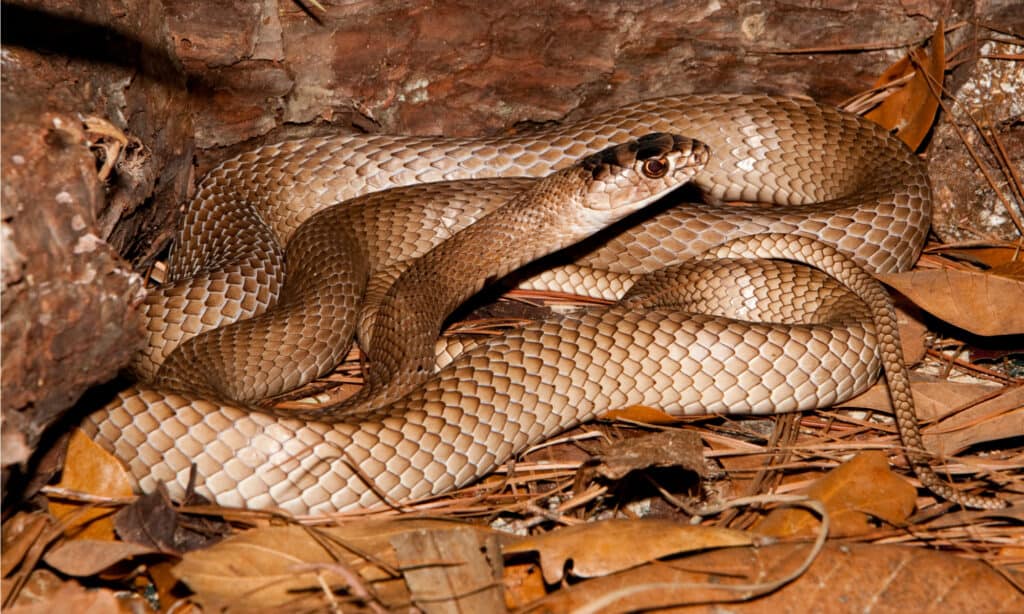
Coachwhips’s scales remind one of a braided leather whip.
©Jay Ondreicka/Shutterstock.com
North American Racer (Coluber constrictor ssp.)
Similar to coachwhips, North American racers are also long and thin. They sometimes periscope, but more often use their legendary speed to chase down prey. There are several different racer subspecies, based on color and location. Most that you find along the Sabine River are eastern yellow-bellied racers.
These nonvenomous speedy snakes can move at around four miles per hour, faster in sprints. Racers are active diurnal hunters that seek shelter when the sun goes down. Although they’re harmless to people, racers are feisty when cornered, often striking repeatedly.
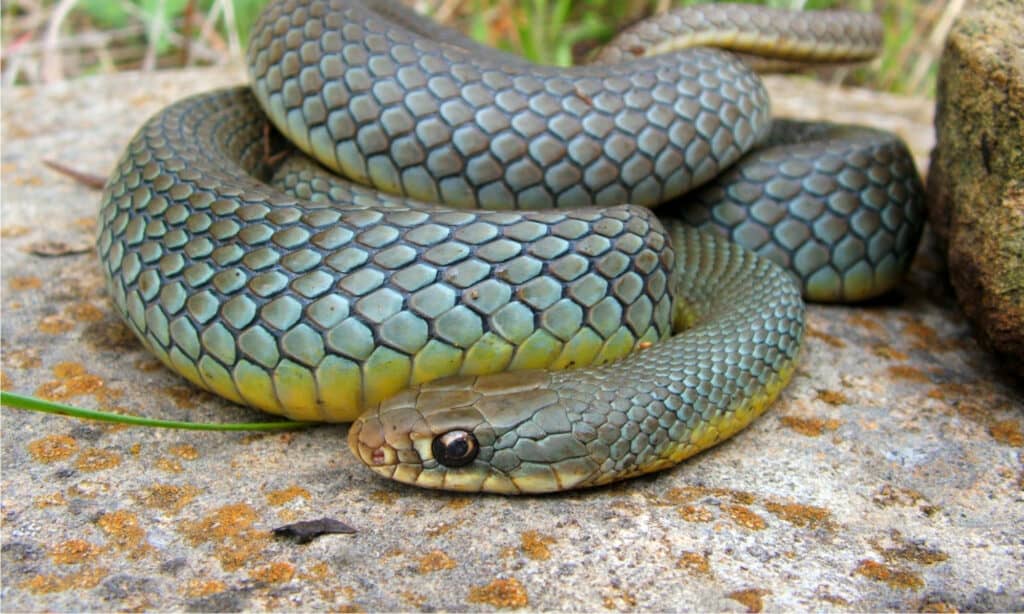
A large and colorful Eastern Yellow-bellied Racer snake, Coluber constrictor flaviventris, coiled with a large meal in its belly.
©Matt Jeppson/Shutterstock.com
Dekay’s Brownsnake (Storeria dekayi)
These little slug eaters spend most of their time hiding under leaf litter, rotten logs, and other similarly moist locations. Dekay’s brownsnakes average around 12 inches long and are quite docile. They almost never bite, but even if they did, it probably wouldn’t hurt.
Common along the Sabine River, Dekay’s brownsnakes are usually brown or gray. They have a lighter dorsal stripe and dark spots on either side of the stripe.

DeKay’s brownsnake preys mostly on soft-bodies animals such as slugs and earthworms.
©Paul Reeves Photography/Shutterstock.com
Rough Greensnake (Opheodrys aestivus)
So named because of their color and lightly keeled scales, rough greesnakes are bright green with cream to yellow colored bellies. They often have yellow just above their bellies on either side, and you probably won’t see one. However, not seeing one of these snakes is normal. Rough green snakes blend into their habitat almost seamlessly.
These harmless mostly arboreal snakes eat a variety of insects and other small arthropods. They are relatively common snakes to find along the Sabine River.

Rough green snakes spend most of their time in shrubs and trees where their color camouflages them from threats and food.
©samray/Shutterstock.com
Speckled Kingsnake (Lampropeltis holbrooki)
These lovely snakes occur in most sections along the Sabine River, but they aren’t known for being in the river. Speckled kingsnakes have distinctive yellow to cream-colored speckles on most of their jet-black dorsal scales with a matching yellow belly.
This species is usually around four feet long but a few record-breaking six-footers have been recorded. Speckled kingsnakes mostly eat small animals like rodents, but they also feast on other snakes — even venomous species.

Speckled kingsnakes are known as the salt and pepper snake because each scale is spotted.
©Cherdchai Chaivimol/Shutterstock.com
Glossy Swampsnake (Liodytes rigida)
Although more common closer to the Gulf Coast, glossy swamp snakes can be found from one end of the Sabine River to the other. These snakes are only about 30 inches long with dark dorsal coloration and lighter belly.
Also called glossy crayfish snakes because of their diet, glossy swamp snakes are harmless and semiaquatic. Their crayfish diet means that you won’t find them far from water, especially slow-moving water.
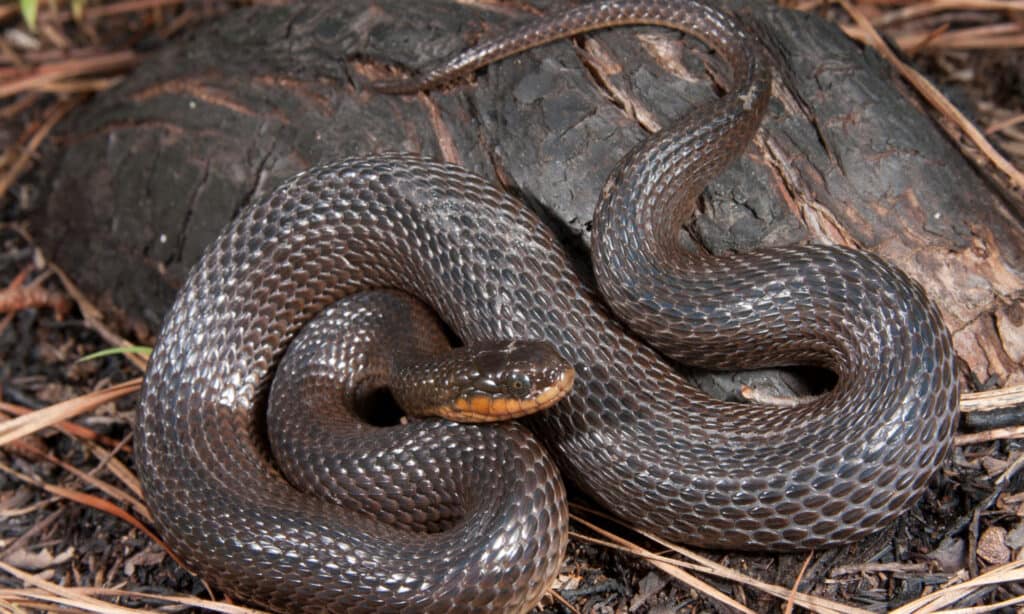
Glossy swamp snakes have shiny scales and eat mostly crayfish.
©Nathan A Shepard/Shutterstock.com
Mudsnake (Farancia abacura)
This snake is almost fully aquatic, only leaving the water to lay eggs. Mudsnakes grow to about four and a half feet long, have cylindrical bodies, and have a high-contrast red belly and black dorsal color pattern. Sometimes mudsnakes lack the red pigments, but they’re still easy enough to identify.
Harmless and not at all aggressive, mudsnakes are more common in the southern end of the Sabine River. However, their range includes the entire length. These snakes eat aquatic salamanders and other amphibians, hunting along the edges of the river and in cypress swamps.
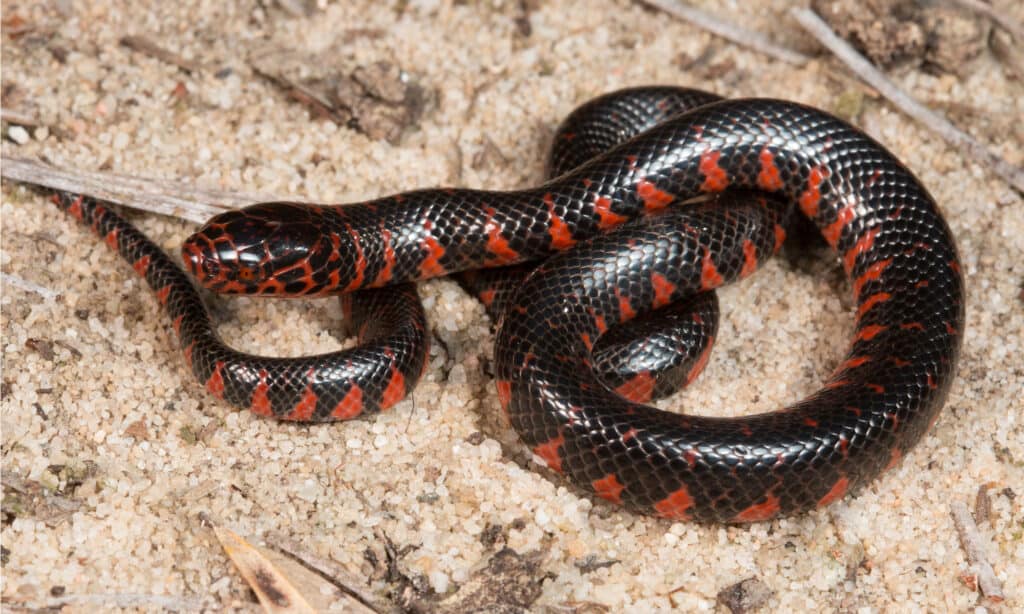
Mud snakes mainly feed on aquatic salamanders and are mostly aquatic.
©Nathan A Shepard/Shutterstock.com
Texas Coral Snake (Micrurus tener)
As beautiful as they are deadly, Texas coral snakes sport the same red, yellow, and black banded pattern as eastern coral snakes. Fortunately, they are not aggressive and do not bite often. If you manage to get bitten by a Texas coral snake, it is probably because you stepped on it or picked it up and harassed it.
Texas coral snakes prefer warm, moist hiding places under logs and leaf litter. They’re very secretive snakes that avoid contact with people whenever possible and slither away when they encounter a person. These snakes are usually pencil-thin, growing to about two to three feet long. They eat a variety of small prey, including snakes.
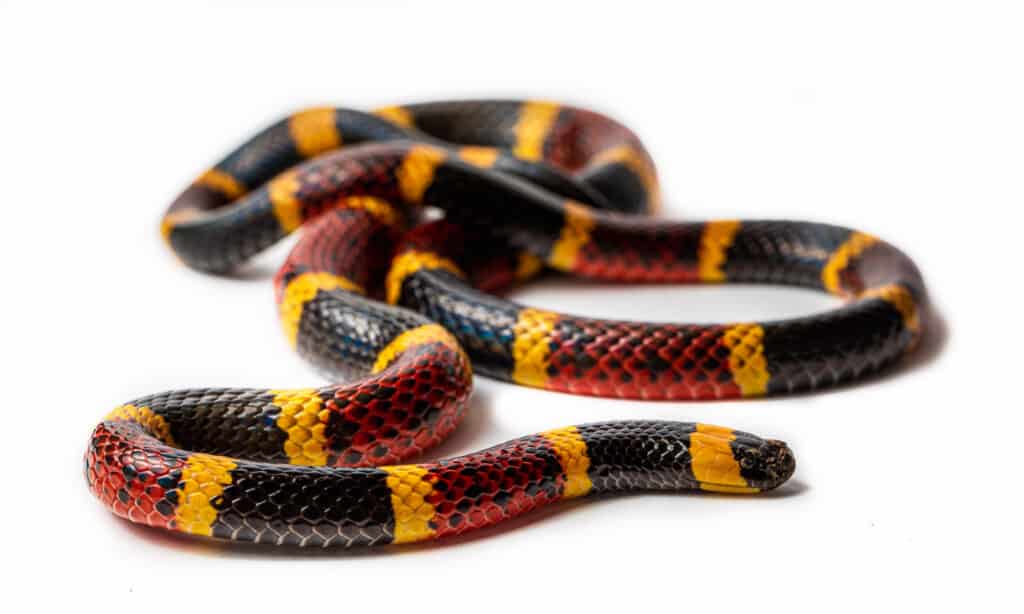
The Texas Coral Snake has a narrow body and is 24 to 48 inches long. Its head is rounded and its eyes are round and black.
©Scott Delony/Shutterstock.com
Timber Rattlesnake (Crotalus horridus)
The feared timber rattlesnake. One of the biggest rattlesnakes in the U.S., timber rattlesnakes can easily grow to six feet long. Their size also allows them to inject massive amounts of venom when they bite — but fortunately, that is a rare occasion. Timber rattlesnakes are very mild-mannered rattlers and typically give you a ton of warning, including rattling, mock strikes, posturing, and finally when all else fails, biting.
This species is a great swimmer and there are plenty of videos showing them swimming across waterways. However, they’re not semiaquatic like watersnakes and cottonmouths. Timber rattlesnakes usually eat small mammals, up to rabbits if it’s a big snake. They are found along most of the Sabine River.
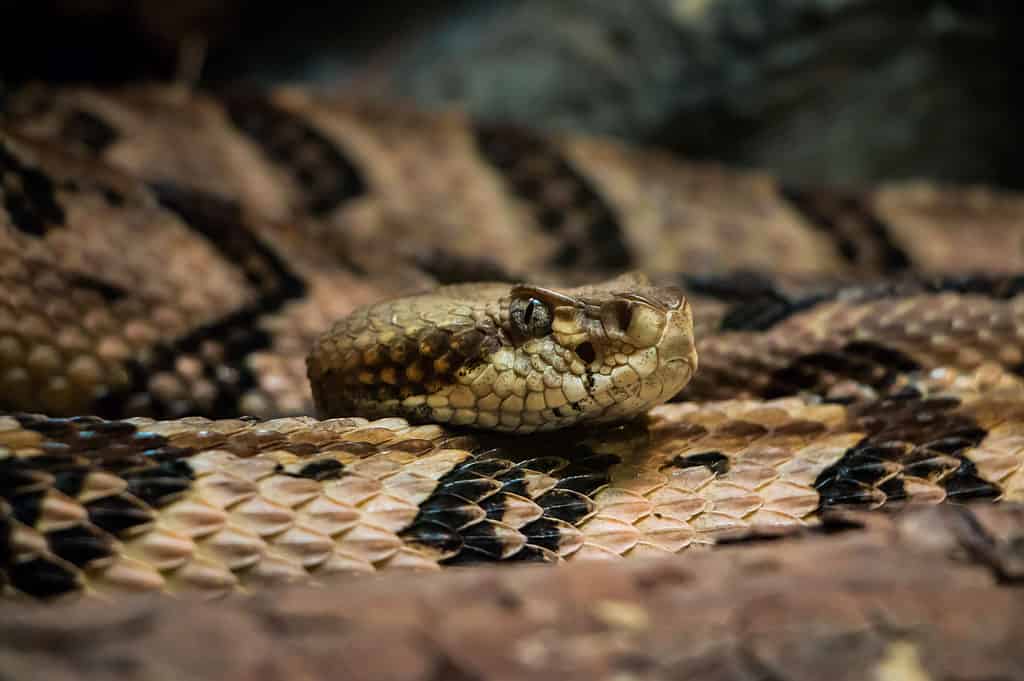
Timber rattlesnakes prefer dry, wooded hill places where they prey on a variety of small warm-blooded animals.
©Dennis Riabchenko/Shutterstock.com
Northern Cottonmouth (Agkistrodon piscivorus)
As mild-mannered as timber rattlesnakes are, cottonmouths can be cranky. And, instead of slithering off into the brush, stand their ground, showing their white mouth at threats. However, although they are venomous, they do not bite as many people as you expect.
Cottonmouth snakes occur all along the Sabine River. They are heavy-bodied, chunky-looking snakes with a wide stripe on each side of their head. These pit vipers eat a little of everything but usually prefer fish and frogs.

Western cottonmouth snake showing off its white mouth to deter predators.
©Ryan M. Bolton/Shutterstock.com
Eastern Copperhead (Agkistrodon contortrix)
These land-loving snakes may be close cousins to cottonmouths and have similar patterns as young snakes, but keep their gorgeous chocolate kiss pattern throughout their lives. Copperheads’ pattern helps them camouflage perfectly into the leaf litter. Unlike other snakes, copperheads don’t slither off when they hear something coming, they freeze. This allows people to step on them and leads to over 3,000 bites annually from copperheads.
Copperheads are on the smaller side, usually growing to less than three feet long. They are generalists and eat a little of anything they can catch, even climbing the trees after cicadas.
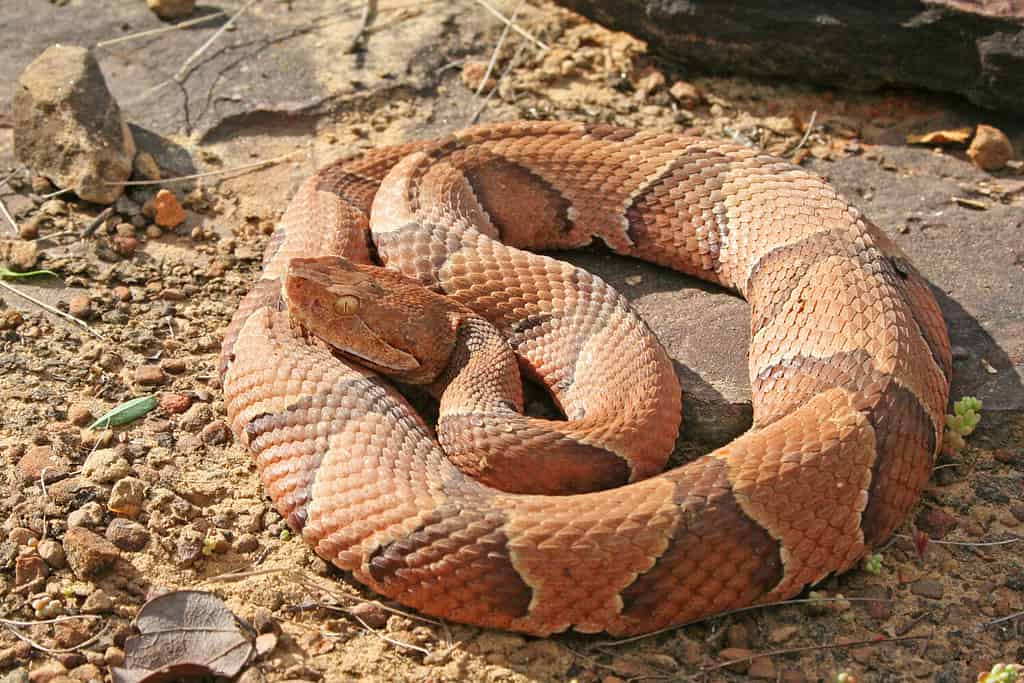
Copperheads freeze when they sense a threat and blend into their habitat.
©Creeping Things/Shutterstock.com
Pygmy Rattlesnake (Sistrurus miliarius)
Despite their name, pygmy rattlesnakes don’t get their name from their size — even though they are small rattlers, only growing to about 20 inches. Instead, their name comes from the fact that their rattle is small.
Pygmy rattlesnake rattles create a much higher-pitched buzzing sound, instead of the notorious rattle you hear from other species.
They eat small rats, mice, lizards, and other small animals wherever they can find them. This species usually prefers a wetter climate like that near lakes, rivers, and marshes where there is abundant cover.
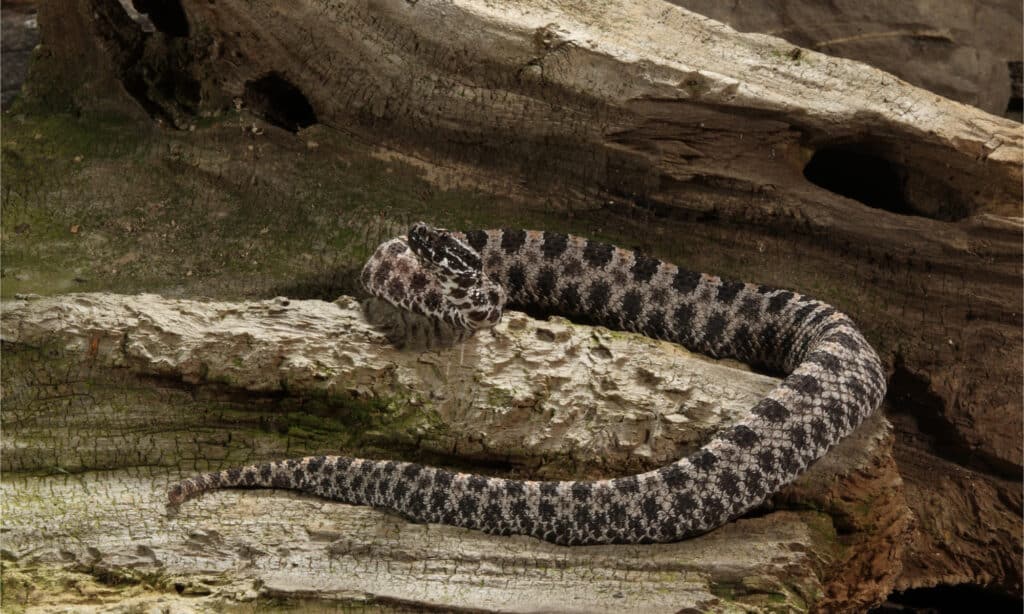
Pygmy rattlesnakes are one of many reptiles slithering along the Sabine River.
©Dennis W Donohue/Shutterstock.com
Snakebite First Aid
Although you may have been told you can cut the snakebite wound open a little and suck the venom out (with or without a device), this is false. Snake fangs are curved and do not form a straight path into or out of the body. Additionally, your muscle tissues move and slide against one another. We have better advice for you!
- Do not use a tourniquet
- Do not ice the bite location
- Don’t attempt to suck out the venom with your mouth or a suction device. Studies show you would only get about 1/10,000th of the venom injected.
- Don’t make any incisions over the wound.
Most of the 8,000 or so venomous snakebites in the U.S. annually do not cause fatalities. If you follow a few simple snakebite tips, you can minimize the damage the venom will do.
- Stay calm to keep your blood pressure and heart rate stable.
- Get to an emergency room or dial 911 for paramedics.
- Wash the bite wound with soap and water, then cover with a clean bandage.
- Remove all constrictive jewelry and clothing.
- Immobilize the area and keep it below the heart if possible.
Other Animals Along the Sabine River
Snakes aren’t the only animals you might see along the Sabine River. The river’s surrounding areas are lush and full of habitat for many species.
- Wild Boar (Sus scrofa) — Invasive in many areas, wild boar can wreak havoc on a farmer’s crops.
- Osprey (Pandion haliaetus) — These majestic birds of prey eat mostly fish that they catch when they swoop down over the water.
- Crested Caracara (Caracara plancus) — These falcon cousins are found as far north as Minnesota.
- Eastern Mud Turtle (Kinosternon subrubrum) — This small turtle only measures three to four inches long. It’s common in the southeastern United States.
What to Do if You Encounter Animals Around the Sabine River
Most of the time, your best bet is to give whatever it is space to get away from you. Wild animals don’t typically want to tangle with humans (except for wild boar), and given the chance will leave.
The river’s 360 miles cross through dozens of counties, with different contact information. Generally, local park rangers can give advice or move an animal if needed.
The photo featured at the top of this post is © Billy Hathorn at en.wikipedia, CC BY-SA 3.0 – License / Original
Discover the "Monster" Snake 5X Bigger than an Anaconda
Every day A-Z Animals sends out some of the most incredible facts in the world from our free newsletter. Want to discover the 10 most beautiful snakes in the world, a "snake island" where you're never more than 3 feet from danger, or a "monster" snake 5X larger than an anaconda? Then sign up right now and you'll start receiving our daily newsletter absolutely free.
Thank you for reading! Have some feedback for us? Contact the AZ Animals editorial team.






